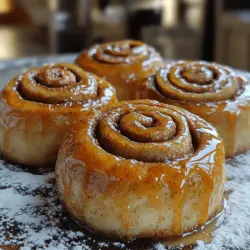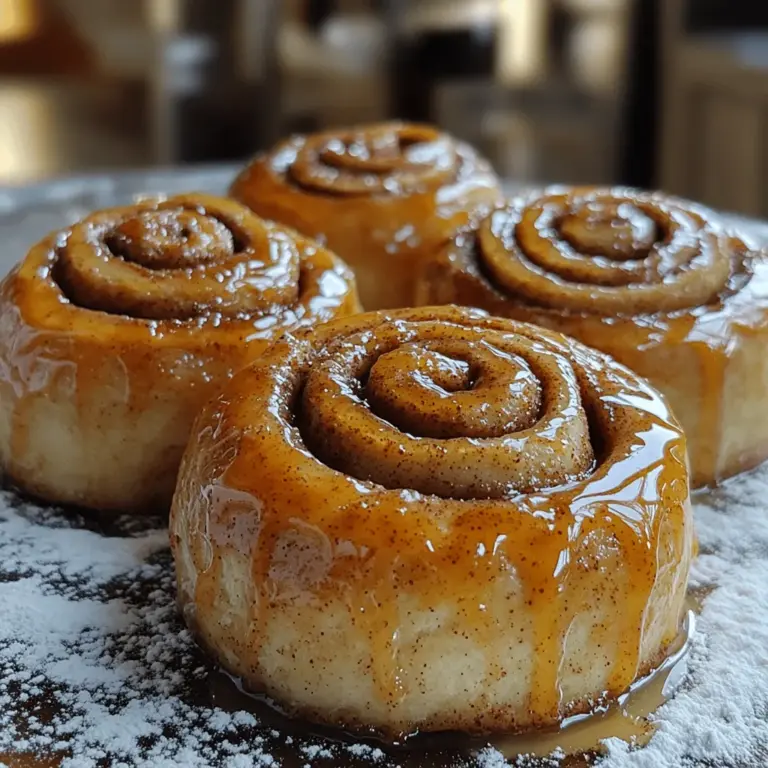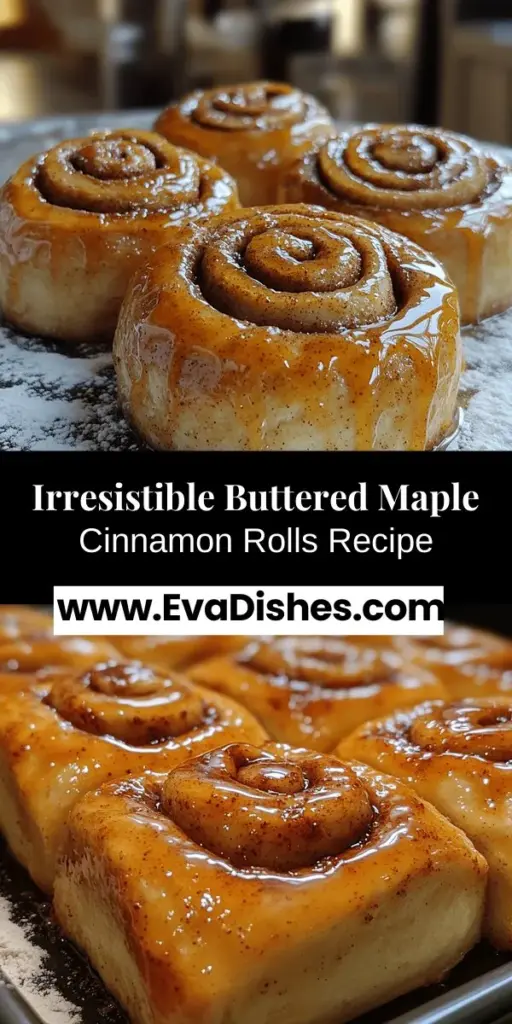Introduction
Buttered maple cinnamon rolls are a deliciously indulgent treat that combines the warmth of freshly baked pastry with the comforting flavors of cinnamon and maple syrup. These rolls are a staple in many households, often enjoyed as a delightful breakfast or a sweet dessert. The aroma that fills your kitchen as they bake is simply irresistible, making them a crowd-pleaser for family gatherings, holiday brunches, or lazy weekend mornings.
The beauty of buttered maple cinnamon rolls lies not only in their taste but also in their texture. Each roll is soft and fluffy, creating a perfect canvas for the sweet filling and the rich maple glaze. The combination of warm spices, creamy butter, and the distinctive taste of pure maple syrup creates a flavor profile that is both nostalgic and satisfying.
In this recipe, we will guide you through making these delectable rolls, focusing on the key components: the dough, the filling, and the maple glaze. With a few simple ingredients and some careful techniques, you’ll be able to whip up a batch of these delightful treats that are sure to impress anyone who takes a bite.
Understanding the Ingredients
Before diving into the recipe, it’s essential to understand the role of each ingredient in creating the perfect buttered maple cinnamon rolls. Each component contributes to the overall flavor, texture, and appearance of the rolls.
Primary Ingredients Used in the Dough
1. All-Purpose Flour:
All-purpose flour serves as the foundation of our dough, providing the necessary structure and texture. Its moderate protein content allows the rolls to rise beautifully while maintaining a soft, tender crumb. If you’re looking for alternatives, bread flour can be used for a chewier texture, while whole wheat flour can be incorporated for a nuttier flavor, but be aware it may require additional hydration.
2. Instant Yeast:
Instant yeast is preferred for this recipe due to its convenience and reliability. This type of yeast doesn’t require proofing, allowing for quicker preparation. It works by fermenting sugars in the flour, producing carbon dioxide that causes the dough to rise. This ensures light and fluffy rolls that are a joy to eat.
3. Whole Milk:
Whole milk plays a crucial role in the dough’s texture, contributing to its richness and moisture. The fat content in whole milk helps create a tender crumb while also enhancing the flavor. If you’re looking for alternatives, you can use almond milk or oat milk, but the richness may be slightly diminished.
4. Unsalted Butter:
Unsalted butter is key to achieving a rich flavor in your cinnamon rolls. The butter not only contributes to the overall taste but also impacts the dough’s texture, helping to create a soft and fluffy roll. It’s important to use unsalted butter so you can control the overall salt content in the recipe.
5. Eggs and Vanilla Extract:
Eggs add richness and moisture to the dough, while also acting as a binding agent. They help to create a tender crumb and provide structure to the rolls. Vanilla extract enhances the flavor profile, adding a warm, aromatic note that complements the cinnamon beautifully.
6. Salt:
While it may seem counterintuitive to add salt to a sweet dough, it plays a vital role in balancing the sweetness. Salt enhances the overall flavor and strengthens the dough by tightening the gluten structure, which results in a better rise.
Explanation of the Filling Ingredients
The filling is where the magic happens, transforming simple dough into a mouthwatering treat.
1. Brown Sugar and Cinnamon:
The combination of brown sugar and cinnamon creates the quintessential flavor profile of cinnamon rolls. Brown sugar adds a deep, caramel-like sweetness that pairs perfectly with the warmth of cinnamon. The specific blend of these ingredients elevates the rolls, making them irresistible.
2. Softened Butter:
Softened butter is essential for binding the filling ingredients together. It allows the brown sugar and cinnamon to spread evenly throughout the dough, ensuring that each roll is filled with flavor. The butter also adds a layer of richness to the filling.
Overview of the Maple Glaze Components
To finish off these delectable rolls, a maple glaze is drizzled on top, adding an extra layer of sweetness and flavor.
1. Powdered Sugar:
Powdered sugar is the base for the glaze, providing sweetness and a smooth texture. It dissolves easily, creating a creamy consistency that’s perfect for drizzling.
2. Pure Maple Syrup:
Pure maple syrup is the star of the glaze, infusing it with its distinct flavor. The syrup provides a rich sweetness that complements the cinnamon rolls beautifully. Always opt for real maple syrup for the best flavor.
3. Milk:
Milk is added to the glaze to achieve the desired consistency. It thins out the powdered sugar and helps create a silky texture that coats the rolls perfectly.
Step-by-Step Instructions for Perfect Rolls
Now that we’ve covered the ingredients, let’s get into the nitty-gritty of making these buttered maple cinnamon rolls.
Preparing the Dough
1. Mixing the Ingredients:
Begin by combining your dry ingredients in a large mixing bowl. This includes all-purpose flour, instant yeast, and salt. Whisk them together to ensure even distribution. In a separate bowl, mix your wet ingredients: whole milk, melted unsalted butter, eggs, and vanilla extract. It’s important to ensure that the milk is warm (about 110°F) before adding it to the yeast. This temperature activates the yeast without killing it.
2. Forming the Dough:
Gradually add the wet ingredients to the dry ingredients, stirring with a wooden spoon or spatula until a shaggy dough forms. Once combined, transfer the dough to a lightly floured surface and knead it for about 8-10 minutes. The goal is to develop the gluten, which will help the rolls rise and maintain their shape. The dough should be smooth and elastic when you’re finished. If it feels too sticky, you can add a little more flour, but be cautious not to add too much.
Kneading Techniques
Kneading is a crucial step that helps develop the structure of the dough. Here are a few tips for effective kneading:
1. Use the Right Technique:
Start by pushing the dough away from you with the heel of your hand, then fold it back over itself. Rotate the dough a quarter turn and repeat. This motion helps to evenly distribute the gluten and ensure a consistent texture.
2. Check for Consistency:
You’ll know your dough is ready when it passes the “windowpane test.” Take a small piece of dough and stretch it gently. If it forms a thin, translucent membrane without tearing, you’ve achieved the right consistency.
The Importance of the First Rise
Once your dough is kneaded to perfection, it’s time for the first rise. This step is crucial for developing flavor and texture.
1. How Yeast Works:
When the dough is left to rise, the yeast ferments the sugars in the flour, producing carbon dioxide gas. This gas gets trapped in the gluten structure of the dough, causing it to expand and rise. The first rise usually takes about 1 to 1.5 hours, or until the dough has doubled in size.
2. Creating the Right Environment:
To encourage a successful rise, place your dough in a warm, draft-free area. You can cover the bowl with a clean kitchen towel or plastic wrap to retain moisture and warmth. If your kitchen is cool, consider preheating your oven for a minute, then turning it off and placing the dough inside.
Preparing the Filling
While the dough is rising, it’s the perfect time to prepare the cinnamon filling.
1. Mixing the Filling Ingredients:
In a medium bowl, combine brown sugar and cinnamon. The ratio can be adjusted based on your preference for sweetness and spice. Make sure to mix them thoroughly to achieve a uniform flavor throughout the filling.
2. Softening the Butter:
Ensure your butter is softened to room temperature. This makes it easier to spread over the dough later.
Once your dough has risen and your filling is ready, you’ll be just a step away from assembling your buttered maple cinnamon rolls. Stay tuned for the next part as we walk through rolling, cutting, and baking these delightful treats!
Insights on Achieving the Right Cinnamon-Sugar Mixture
The heart of any great cinnamon roll lies in its filling, primarily composed of the cinnamon-sugar mixture. To achieve the perfect balance of sweetness and spice, opt for a high-quality ground cinnamon. Ceylon cinnamon is often recommended for its delicate flavor profile, while cassia cinnamon is more commonly found and offers a bolder taste. Mix your chosen cinnamon with granulated sugar, ensuring that you maintain a ratio that suits your palate—typically, a 1:2 ratio of cinnamon to sugar works well. For a unique twist, consider adding a pinch of nutmeg or a dash of vanilla extract to enhance the flavor complexity.
Rolling Out the Dough
Now that your dough has risen, it’s time to roll it out. Lightly flour your work surface to prevent sticking, and gently punch down the dough to release any air bubbles. Using a rolling pin, carefully roll the dough into a large rectangle, aiming for about ¼ inch in thickness. The size of your rectangle can vary depending on how large you want your cinnamon rolls to be, but a general guideline is 12×18 inches. Ensure the edges are even to maintain uniformity in the rolls.
Techniques for Achieving the Ideal Thickness and Size
Maintaining an even thickness is crucial for ensuring that all rolls bake uniformly. If you find the dough is sticking to the rolling pin, sprinkle a bit more flour on top, but avoid over-flouring, as this can result in a dry dough. Additionally, if you prefer larger rolls, increase the size of your rectangle; for smaller rolls, decrease the dimensions. Consistency is key, so check the thickness periodically as you roll.
Shaping the Rolls
Once the dough is rolled out and your cinnamon-sugar mixture is prepared, it’s time to assemble. Spread the mixture evenly across the dough, leaving a small border around the edges. This prevents the filling from spilling out when you roll it up.
To shape the rolls, start from one long edge and gently roll the dough towards the opposite side, forming a tight log. The tighter you roll, the better the layers will hold together during baking. Once rolled, you’ll want to cut the log into equal sections. A sharp knife or dental floss works wonders here—simply slide the floss under the log, cross it over the top, and pull it tight to create clean cuts without squishing the dough.
Tips for Cutting and Sealing the Rolls Effectively
To ensure the rolls remain sealed during baking, you can lightly pinch the edge of the dough after cutting. This small step helps maintain the filling inside the roll. For a more decorative touch, you might consider cutting the rolls into different sizes—larger ones for those who love a hearty treat and smaller ones for those who prefer a lighter snack.
The Second Rise: Why It Matters
After shaping the rolls, place them in a greased baking dish, ensuring they’re close together but not touching. Cover them with a clean towel and allow them to rise again in a warm spot for about 30-45 minutes. This second rise is critical; it allows the dough to expand and develop that fluffy texture we all love in cinnamon rolls. The yeast continues to work its magic, creating air pockets that will result in soft and tender rolls once baked.
Baking the Cinnamon Rolls
Preheating the Oven
While the rolls are rising, preheat your oven to 350°F (175°C). This step is essential for achieving even baking. An oven that is too hot can cause the rolls to brown too quickly on the outside while leaving the insides doughy. Conversely, an oven that’s not hot enough can lead to dense rolls that lack that desired pillowy texture.
Baking Tips
When your rolls have completed their second rise and are fluffy and puffy, it’s time to bake. Place the dish in the preheated oven and set a timer for 25-30 minutes. Keep an eye on them, as baking times can vary based on your oven and the size of the rolls. Look for a golden-brown hue on the tops, and when lightly tapped, they should sound hollow. If you notice they are browning too quickly, you can cover them loosely with aluminum foil to prevent over-browning.
Creating the Maple Glaze
Step-by-Step Guide to Making the Glaze
While your rolls are baking, it’s time to prepare the maple glaze that will take your cinnamon rolls to the next level. In a mixing bowl, combine powdered sugar, maple syrup, and a splash of milk or cream. Whisk the mixture until smooth and well combined. The consistency should be thick but pourable—adjust with more liquid or sugar as necessary to achieve your desired thickness.
Importance of Achieving the Right Consistency
The right glaze consistency is vital; too runny, and it will slide right off the rolls, too thick, and it will be difficult to drizzle. Aim for a texture that allows for a beautiful drizzle over the warm rolls, creating a visually appealing and delicious topping.
How to Drizzle the Glaze for Maximum Flavor
Once your rolls are out of the oven and slightly cooled, use a spoon or a piping bag to drizzle the glaze generously over the top. Focus on drizzling along the edges and allowing the glaze to cascade down the sides, ensuring every bite is infused with that delightful maple flavor.
Serving Suggestions
To truly enjoy your buttered maple cinnamon rolls, serve them warm. They pair wonderfully with a hot cup of coffee or tea, enhancing the comforting experience. For a more indulgent breakfast or brunch, consider serving with a side of fresh fruit or yogurt to balance the sweetness.
Best Practices for Serving Warm Rolls
To keep your rolls warm, you can cover them with a clean kitchen towel after glazing. If you’re serving them later, you can gently reheat them in a microwave for 10-15 seconds each, just enough to warm them through without drying them out.
Ideas for Pairings
Pairing these cinnamon rolls with beverages like a robust black coffee or a spiced chai tea can elevate the experience. For an even more decadent treat, serve with a dollop of whipped cream or a scoop of vanilla ice cream on the side.
Suggestions for Storing Leftovers and Reheating
If you have leftovers, store them in an airtight container at room temperature for up to two days. For longer storage, consider wrapping them individually in plastic wrap and placing them in the freezer, where they can last for up to three months. To reheat, simply thaw them overnight in the refrigerator and warm them in the oven or microwave before serving.
Nutritional Information
Each buttered maple cinnamon roll contains approximately 300 calories, with a balance of carbohydrates, sugars, and fats. While these rolls are a delightful indulgence, portion control is essential, especially if you’re mindful of your diet. Enjoying one or two rolls as a special treat can be a joyous experience, but be cautious of overindulgence, as the sugars can add up quickly.
Conclusion
Making homemade buttered maple cinnamon rolls is not just about following a recipe; it’s about enjoying the process of baking and the joy of sharing homemade treats with loved ones. The warm aroma filling your kitchen as the rolls bake is an experience in itself, and the first bite of a warm roll drizzled with maple glaze is truly heavenly.
As you experiment with this recipe, feel free to personalize it—try adding nuts, dried fruits, or even experimenting with different fillings. The possibilities are endless, and each batch can be a new adventure. So roll up your sleeves, gather your ingredients, and enjoy the delightful journey of making these cinnamon rolls from scratch. Whether for a special occasion or a cozy weekend breakfast, these rolls are sure to bring smiles to your table.



